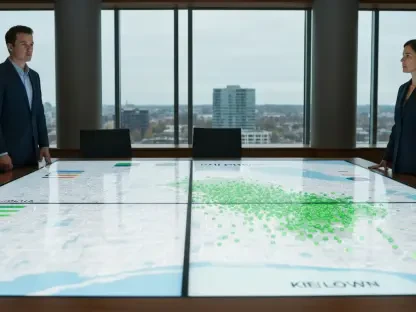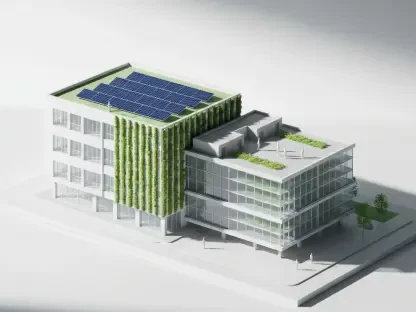As we traverse the landscape of Europe’s construction industry in 2025, the sector is positioned at a crossroads, poised for significant transformation and growth. The industry forms a vital cornerstone of Europe’s economy, not merely in terms of sheer market size, which stands at an impressive USD 3,225.27 billion, but also through its profound impact on employment and urbanization. Looking ahead, the market is projected to ascend to USD 4,327.39 billion by 2033, driven by a compound annual growth rate (CAGR) of 3.32%. This potential for growth is rooted in key sectors such as residential, commercial, industrial, and infrastructure development. As the continent grapples with urgent demands for modernization, green innovations, and digital advancements, the construction sector’s role becomes increasingly prominent in shaping sustainable urban futures.
Strategic Investments and Urbanization: Driving Forces
Infrastructure Modernization: Boosting Competitiveness
In the wake of economic shifts and the evolving priorities of the European Union, governmental investment has become a crucial catalyst for infrastructure modernization across Europe. This investment focuses heavily on upgrading critical components such as transportation, energy, and digital infrastructure, all of which are essential for sustaining economic vitality. The European Investment Bank’s substantial commitment of over €250 billion between 2025 and 2027 underscores a significant financial impetus aimed at bolstering economic competitiveness and technological resilience. This strategic injection of funds is designed to address critical vulnerabilities, ensuring that the infrastructure not only meets current demands but also anticipates future challenges.
Germany stands out as a frontrunner in this modernization push, with its strong industrial backbone and governmental inclination toward sustainable development initiatives. These efforts encompass an array of projects, from green mobility enhancements to energy-efficient building regulations, which collectively contribute to a modernized, competitive infrastructure landscape. However, the scope is not limited to a single nation; throughout Europe, there is a palpable shift toward smarter and more energy-efficient urban environments. This broader trend recognizes that the future of competitiveness lies not only in traditional infrastructure but also in integrating new technologies that promote efficiency and sustainability.
Urbanization and Housing Demand: Responding to Demographic Shifts
In tandem with governmental initiatives, the relentless march of urbanization exerts additional pressure on the construction sector. Demographic trends point to an increase in demand for residential buildings, particularly in burgeoning urban areas where young professionals and families seek affordable housing. Nations such as France and the Netherlands have responded proactively, rolling out housing stimulus packages designed to alleviate shortages. France’s ambitious €15 billion initiative aims to deliver 70,000 new homes annually while ensuring these additions align with broader ecological goals, thereby addressing both demographic demands and sustainability.
This significant focus on urban living is not limited to housing. As cities continue to expand, the infrastructure supporting them—ranging from public transport systems to digital networks—must evolve accordingly. The challenge lies in developing these systems in ways that can accommodate growing populations without compromising on sustainability objectives. Urban planners and developers find themselves balancing these needs, striving to create environments that are livable, efficient, and ecologically sensitive. The emphasis on creating affordable, yet high-standard living conditions highlights the need for a comprehensive approach that integrates new technologies and sustainable practices, crucial elements in meeting Europe’s multifaceted urbanization challenges.
Overcoming Challenges in Material Costs and Labor
Material Costs and Supply Chain Disruptions: Navigating Complications
Even as Europe’s construction sector enjoys promising prospects, it faces significant headwinds in the form of rising material costs and pervasive supply chain disruptions. These challenges have proven particularly taxing for project budgets, exacerbated by a confluence of inflationary pressures, geopolitical tensions, and ongoing logistical bottlenecks. Critical materials such as steel, cement, and timber have witnessed steep price increases, at times skyrocketing project costs and injecting a degree of unpredictability that project managers and financiers find hard to mitigate.
The ongoing crisis between Ukraine and Russia has further highlighted the vulnerabilities inherent in global supply chains. These geopolitical tensions have severely hampered the flow of raw materials, presenting an additional layer of complexity for construction initiatives reliant on timely and cost-efficient procurement. In this volatile landscape, construction firms are compelled to exercise innovative strategies, such as diversifying their supplier base and embracing alternative materials, to mitigate risk. The emphasis on sustainability also nudges companies toward sourcing environmentally responsible materials, although these efforts must contend with market realities of cost and accessibility.
Labor Shortages and Skills Gaps: Addressing Workforce Constraints
Labor shortages pose another significant hurdle for the construction sector. Many countries across Europe continue to grapple with a deficit of skilled workers, a shortfall that risks derailing projects and inflating costs. Current estimates suggest a shortfall of over 500,000 construction workers across Europe. This labor gap not only impacts project timelines but also exerts pressure on wages, contributing to the overall financial burden on companies seeking to maintain competitive edges amidst rising operational costs.
To address this persistent challenge, various countries have launched initiatives aimed at attracting younger generations into the industry through vocational training and outreach programs. However, the response has been slower than anticipated. Despite these hurdles, there remains optimism that a pivot toward digital transformation might alleviate some pressure. Technologies such as automation and AI offer paths to streamline operations and reduce the dependency on manual labor. Nevertheless, the successful integration of these technologies requires strategic investment and a shift in traditional mindset, both of which are fundamental in equipping the workforce to meet industry demands in a rapidly changing construction landscape.
Innovations and Sustainable Practices: The Key to Future Growth
Advancing Green Building Standards: Aligning with Sustainability Goals
The movement towards adopting green building standards is gaining significant momentum across Europe, driven by both regulatory frameworks and shifting consumer expectations. This shift aligns with the objectives of the European Green Deal, which advocates for the use of sustainable construction methodologies that minimize environmental impact and promote energy efficiency. Green certifications have become increasingly prioritized in new development projects, underscoring an industry trend that values ecological sustainability as much as economic viability.
Countries like France are leading this charge by implementing policies that stress ecological building standards such as net-zero energy consumption. Initiatives like RE2020 in France aim to transition construction practices toward greater ecological responsibility, influencing both the design and material selection of new buildings. The integration of green technologies and renewable energies into construction is not only a response to regulatory mandates but also a reflection of growing consumer awareness and demand for sustainable living options. As market dynamics evolve, the construction industry is witnessing an infusion of innovations designed to enhance sustainability, from eco-friendly materials to smart energy systems.
Digital Transformation: Reshaping Construction Practices
Parallel to the embrace of sustainable practices, the digital transformation in the construction industry promises to revolutionize project execution and operational efficiency. Technologies such as Building Information Modeling (BIM), artificial intelligence, and automation provide powerful tools to streamline project planning, reduce waste, and increase precision. The use of drones for surveying and monitoring, along with AI-powered analytic tools, enables project managers to make data-driven decisions that enhance productivity and efficiency, crucial factors for staying competitive in a crowded market.
Smart construction technologies also address some of the challenges posed by labor shortages, providing solutions that reduce the reliance on manual labor without compromising quality. Automated systems and robotics are redefining work processes, ensuring that construction projects can proceed even amidst workforce constraints. The broader implementation of these technologies is transforming the construction sector into a more adaptive and dynamic industry, capable of meeting future demands while providing enhanced value through increased sophistication and global competitiveness.
Navigating Regulatory Complexities and Financing Challenges
Regulatory Complexity: Overcoming Operational Barriers
The regulatory landscape across Europe presents a labyrinthine array of challenges for construction firms, particularly those multi-national corporations that operate across various jurisdictions. Regulations can vary not only from country to country but also within different regions of a single country, encompassing a spectrum of building codes, safety standards, and environmental directives. These discrepancies can lead to extensive operational delays and increase compliance costs, impeding the swift execution of projects that require transnational cooperation.
Moreover, navigating such regulatory complexities demands significant administrative resources and an intricate understanding of local legalities, a task that can be daunting for even the most seasoned firms. For businesses large and small, the need for adept regulatory navigation skills is imperative, where strategic partnerships with local stakeholders and investments in compliance expertise can yield tangible benefits. The increasing regulatory focus on sustainability and safety underscores the importance of preemptive planning and adaptability, integral factors for thriving in Europe’s dynamic construction market.
Financing Constraints: Balancing Risk and Opportunity
Financing remains a persistent challenge in the construction sector, amplified by volatile interest rates and tightened credit markets. These financial constraints particularly impact mid-sized developers who may find it difficult to secure favorable terms in an environment of stringent lending conditions and heightened risk assessment criteria. As financial institutions continue to exercise caution, access to capital becomes a limiting factor for many projects, especially those involving complex public-private partnerships.
To mitigate these challenges, construction firms are increasingly exploring alternative financing models, such as crowdfunding and strategic partnerships with investment funds. These initiatives not only enhance liquidity but also spread risk across diverse financial participants. In tandem, the embrace of sustainable financing, which caters specifically to green building initiatives with favorable terms, presents a new avenue for firms seeking to enhance their funding options. The ability to effectively navigate these financial landscapes provides a competitive edge, enabling firms to seize opportunities in a sector that promises both risk and reward.
Competitive Landscape: Market Dynamics and Strategic Insights
Key Players and Market Fragmentation: The Competitive Edge
The competition within Europe’s construction market is characterized by fragmentation, with a mix of major multinationals and nimble regional companies vying for dominance. Giants such as Vinci, Skanska, and Bouygues Construction lead significant projects due to their expansive resources and capabilities, often securing high-profile contracts tied to infrastructure, commercial developments, and innovative building projects. Their robust market presence is supported by strategic initiatives focusing on sustainable building practices, technological integration, and cultivating strong industry partnerships.
Despite the presence of these large players, regional firms maintain a solid foothold, excelling in niche areas where specialization and local expertise are prioritized. These firms often leverage their intimate knowledge of regional regulations and market dynamics to execute projects efficiently, providing a stiff challenge to larger enterprises. As the market evolves, the drive toward digitalization and sustainability presents both challenges and opportunities, fostering a competitive environment where innovation and strategic foresight become key differentiators.
Strategic Actions Shaping the Future: Aligning with Market Trends
The competitive landscape of the European construction sector is evolving, as leading companies adopt strategies to position themselves for future success in an increasingly sustainable and digitally-driven market. Top players focus on fostering sustainable construction practices, aligning their operations with ongoing shifts toward green methodologies and environmental stewardship. Digital adoption forms another strategic pillar; through leveraging cutting-edge technologies, firms aim to enhance efficiency, reduce costs, and deliver high-quality projects within competitive timelines.
Additionally, strategic partnerships and alliances are becoming more prevalent as companies seek to broaden their reach and capabilities. These partnerships can span diverse sectors, encompassing everything from collaborations with tech firms for digital initiatives to engagements with financial institutions for innovative financing models. As firms continue to adapt and innovate, the construction industry is poised to become a cornerstone of Europe’s sustainable economic development, reflecting broader societal shifts toward environmental consciousness and technological progress.
The Road Ahead: Embracing Change and Innovation
In conclusion, Europe’s construction sector is at a pivotal juncture, navigating a landscape shaped by evolving demands for modernization, sustainability, and digital innovation. Strategic investments serve as a crucial foundation for infrastructure enhancements, meeting urbanization pressures and aligning with ecological goals. The challenges of material costs, labor shortages, and regulatory complexities remain persistent, yet they also present opportunities for strategic adaptation and innovation.
Embracing green building standards and digital transformations is key to addressing these challenges, aligning the industry with both regulatory mandates and consumer expectations for sustainable practices. Furthermore, navigating regulatory complexities and financing challenges requires astute strategic planning and market awareness. As the market dynamics evolve, the construction sector remains poised to play a central role in Europe’s economic future, underscoring the need for a collaborative approach in championing sustainability and technological adoption. By continuing to innovate and adapt, the industry sets a course for sustainable growth, shaping a future that harmonizes economic aspirations with environmental commitments.









